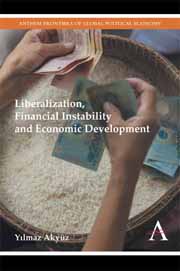Book contents
- Frontmatter
- Dedication
- Contents
- Introduction
- PART ONE LIBERALIZATION, STABILITY AND GROWTH
- PART TWO THE GLOBAL ECONOMIC CRISIS AND DEVELOPING COUNTRIES
- Chapter VI The Current Global Financial Turmoil and Asian Developing Countries
- Chapter VII The Global Economic Crisis and Asian Developing Countries: Impact, Policy Response and Medium-Term Prospects
Chapter VI - The Current Global Financial Turmoil and Asian Developing Countries
from PART TWO - THE GLOBAL ECONOMIC CRISIS AND DEVELOPING COUNTRIES
- Frontmatter
- Dedication
- Contents
- Introduction
- PART ONE LIBERALIZATION, STABILITY AND GROWTH
- PART TWO THE GLOBAL ECONOMIC CRISIS AND DEVELOPING COUNTRIES
- Chapter VI The Current Global Financial Turmoil and Asian Developing Countries
- Chapter VII The Global Economic Crisis and Asian Developing Countries: Impact, Policy Response and Medium-Term Prospects
Summary
Introduction
After almost six years of exceptional performance, the world economy has now entered a period of uncertainty due to a financial turmoil triggered by the subprime mortgage crisis in the United States. World economic growth and stability in the next few years will depend crucially on the impact of the crisis on the United States economy and its global spillovers. The resilience of emerging markets to direct and indirect shocks from the crisis will no doubt play an important role, since much of global growth in recent years has been due to expansion in these economies, notably in Asia. The extent to which growth and stability in Asian emerging markets can be decoupled crucially depends on prevailing domestic economic conditions as well as the policy response to possible shocks from the crisis.
This chapter takes up these issues. The following section posits the main theme of the paper that current difficulties in the United States economy and vulnerabilities in emerging markets are not unrelated to financial excesses that made a major contribution to global expansion in the past six years, including credit, asset and investment bubbles triggered by rapid expansion of global liquidity.
Section C takes up the causes, nature and the severity of the crisis in the United States, and the policy response already underway with a view to assessing their possible effects on growth and external adjustment.
- Type
- Chapter
- Information
- Liberalization, Financial Instability and Economic Development , pp. 223 - 258Publisher: Anthem PressPrint publication year: 2014



